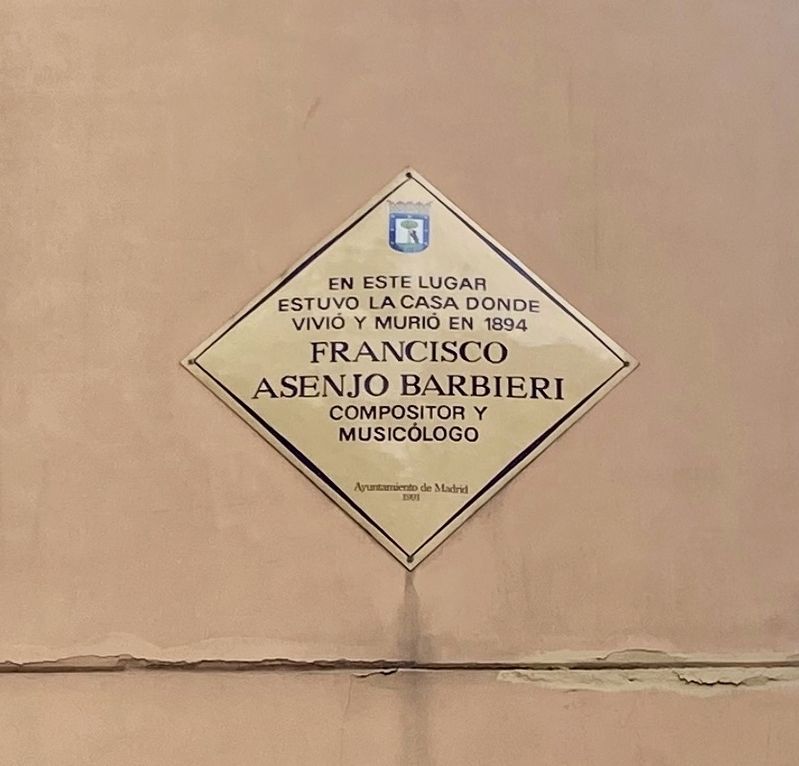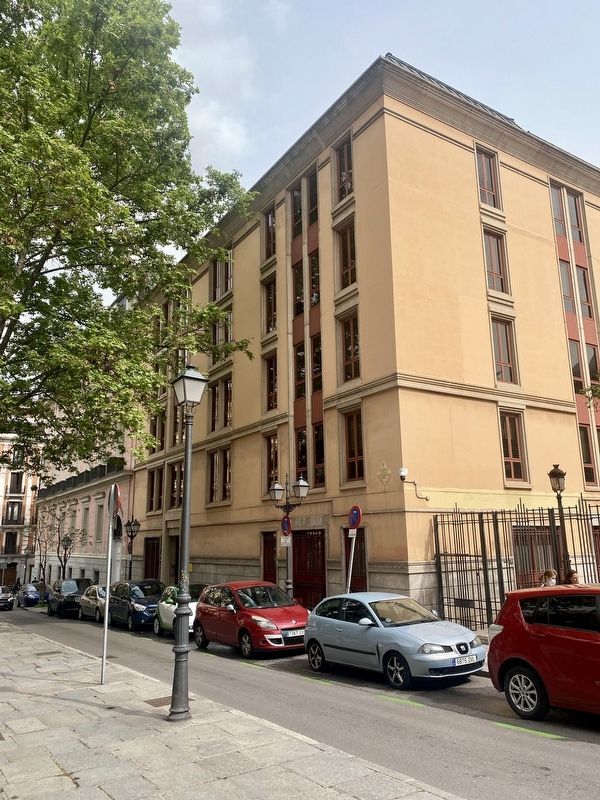Justicia in Madrid, Spain — Southwestern Europe (Iberian Peninsula)
Francisco Asenjo Barbieri
En este lugar estuvo la casa donde vivió y murió en 1894 Francisco Asenjo Barbieri compositor y musicólogo
At this site was located the house where the composer and musicologist Francisco Asenjo Barbieri lived, and died in 1894.
Erected 1991 by Ayuntamiento de Madrid.
Topics and series. This historical marker is listed in this topic list: Arts, Letters, Music. In addition, it is included in the City of Madrid - "Yellow Diamond" series list. A significant historical date for this entry is August 3, 1823.
Location. 40° 25.2′ N, 3° 41.781′ W. Marker is in Madrid. It is in Justicia. Marker is on Plaza del Rey, on the left when traveling west. Touch for map. Marker is in this post office area: Madrid 28004, Spain. Touch for directions.
Other nearby markers. At least 8 other markers are within walking distance of this marker. Lyceum Club Femenino / Women's Lyceum Club (within shouting distance of this marker); Casa de las Siete Chimeneas / House of the Seven Chimneys (within shouting distance of this marker); Teatro Circo Price (within shouting distance of this marker); Banco Bilbao Vizcaya (about 90 meters away, measured in a direct line); Teatro Apolo (about 90 meters away); Félix Lope de Vega (about 120 meters away); Enrique Jardiel Poncela (about 120 meters away); Santa María Micaela (Madre Sacramento) (about 120 meters away). Touch for a list and map of all markers in Madrid.
More about this marker. The marker is located on the south side of the plaza and is visible from afar (from the right angle).
Also see . . .
1. Francisco Asenjo Barbieri (Wikipedia).
Excerpt: "Francisco Asenjo Barbieri (3 August 1823 – 19 February 1894) was a well-known composer of the popular Spanish opera form, zarzuela....He was born and died in Madrid, appropriately, since the themes and characters of his operas are often distinctly Spanish and Madrilenian. Among the characters featured by Barbieri are bullfighters, manolos and manolas, and even (in Pan y toros) the famous Spanish painter, Francisco Goya.(Submitted on May 11, 2022, by Andrew Ruppenstein of Lamorinda, California.)
The character of much of Barbieri’s work is farcical, utilizing mistaken identity and other devices to entertain the audience. His themes deal largely with the ins and outs of love, and the relations between the upper and lower classes in nineteenth-century Spain, but there is also a distinct political character to much of his work. The zarzuelas El barberillo de Lavapiés and Pan y toros both contain plots to overthrow the government."
2. Canción de Paloma by Francisco Asenjo Barbieri (YouTube, 3.5 min.). Performance of Canción de Paloma by Luna Poveda, accompanied by la Banda Sinfónica de Requena. (Submitted on May 11, 2022.)
Credits. This page was last revised on February 2, 2023. It was originally submitted on May 11, 2022, by Andrew Ruppenstein of Lamorinda, California. This page has been viewed 64 times since then and 6 times this year. Photos: 1, 2. submitted on May 11, 2022, by Andrew Ruppenstein of Lamorinda, California.

